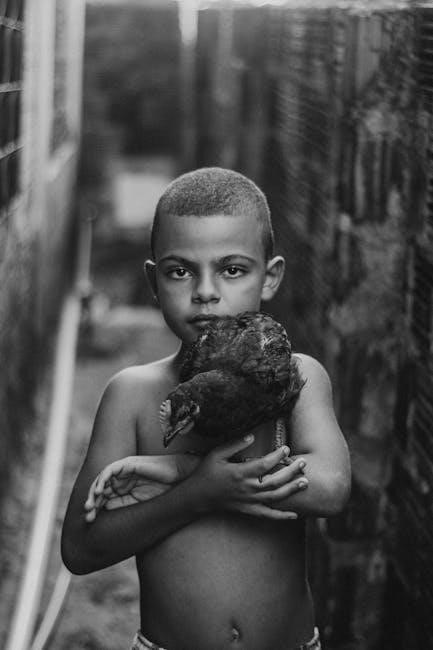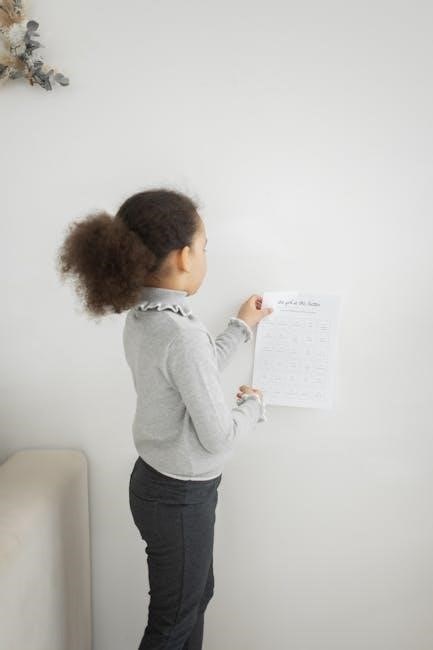Simple Probability Worksheet PDF: A Comprehensive Guide
This guide provides a comprehensive overview of simple probability worksheets in PDF format. It explores their purpose‚ benefits‚ and how they aid in learning fundamental probability concepts. Discover resources for various grade levels. Understand how these worksheets help grasp core concepts. Learn where to find free and printable options.
Simple probability is the bedrock of understanding chance and randomness. It’s a concept that helps us quantify how likely an event is to occur. It’s the foundation for more complex statistical analysis. At its core‚ simple probability involves calculating the ratio of favorable outcomes to the total possible outcomes. This basic understanding is crucial for making informed decisions in everyday life. From predicting weather patterns to understanding the odds in games of chance‚ probability plays a significant role.
Simple probability worksheets serve as an excellent tool for introducing and reinforcing these foundational concepts. These worksheets often feature scenarios involving dice‚ coins‚ cards‚ and marbles‚ providing relatable contexts for learners. By working through these exercises‚ students develop the ability to identify possible outcomes‚ calculate probabilities‚ and express them as fractions or decimals. This practical application solidifies their understanding of probability and builds a strong foundation for future learning. Simple probability is‚ therefore‚ not just a mathematical concept but a life skill.
Understanding Basic Probability Concepts
Grasping basic probability concepts involves understanding key terms and principles. An “event” is a specific outcome we’re interested in. The “sample space” encompasses all possible outcomes. Probability is calculated as the number of favorable outcomes divided by the total number of outcomes in the sample space; This is typically expressed as a fraction‚ decimal‚ or percentage. It’s crucial to differentiate between theoretical and experimental probability.
Theoretical probability is what we expect to happen based on calculations. Experimental probability is what actually happens during trials. Understanding these differences is vital for interpreting data and making predictions. Additionally‚ concepts like independent and dependent events play a significant role. Independent events do not affect each other‚ while dependent events do. Worksheets often present problems that require identifying these types of events and calculating their probabilities. By mastering these basic concepts‚ learners gain a solid understanding of how probability works in real-world scenarios. They also learn how to apply probability to make informed decisions.
Probability with Dice: Worksheet Exercises
Dice-related exercises in probability worksheets provide a practical way to understand theoretical probability. A standard six-sided die offers outcomes from 1 to 6. Worksheets often ask for the probability of rolling a specific number‚ an even number‚ or a number greater than 4. These exercises reinforce the concept of sample space. They also highlight the calculation of favorable outcomes versus total outcomes. More advanced problems might involve rolling two dice and calculating the probability of sums. For example‚ determining the probability of rolling a sum of 7 or a sum greater than 9.
These scenarios introduce the concept of combined events. They require students to consider all possible combinations of outcomes. Some worksheets include questions about the probability of rolling specific combinations. For instance‚ rolling a 6 on one die and a 3 on the other. These exercises encourage students to create sample spaces of paired outcomes. Solving these problems enhances understanding of probability calculations. It also reinforces the ability to apply probability to real-world situations involving random events.
Probability with Spinners: Worksheet Examples
Spinner-based probability worksheet examples offer a visual and engaging way to explore probability concepts. Spinners are typically divided into sections of varying sizes‚ each representing a different outcome. Worksheets often present scenarios where students must determine the probability of the spinner landing on a particular color or number. The probability is calculated by dividing the number of favorable sections by the total number of sections. For example‚ if a spinner has 8 sections and 3 are blue‚ the probability of landing on blue is 3/8.

Some worksheets include more complex scenarios‚ such as determining the probability of landing on a prime number or a section with a specific attribute. These exercises require students to analyze the spinner carefully. They must identify favorable outcomes based on given criteria. Furthermore‚ some examples may involve multiple spins‚ where students calculate the probability of sequential events. For instance‚ what is the probability of spinning red followed by green? Spinner problems enhance understanding of fractions‚ ratios‚ and the relationship between visual representation and numerical probability.
Probability with Cards: Worksheet Problems
Probability problems involving playing cards are a classic method for teaching basic probability concepts. A standard deck of 52 cards provides a well-defined sample space‚ allowing for numerous variations in problem design. Worksheets typically ask students to calculate the probability of drawing specific cards or combinations of cards from the deck. For example‚ determining the probability of drawing a heart or a king involves understanding the composition of a deck.
Problems often involve calculating the probability of drawing a particular card‚ such as the Ace of Spades. They also cover drawing a card of a specific suit. Additionally‚ they may require calculating the probability of drawing face cards (Jack‚ Queen‚ King) or number cards within a given range. Some advanced problems introduce concepts like conditional probability. This involves calculating probabilities given that certain cards have already been drawn without replacement. For instance‚ what is the probability of drawing a second heart after one heart has already been removed from the deck? Card-based probability problems enhance analytical skills.
Probability with Marbles/Objects: Worksheet Scenarios
Probability scenarios involving marbles or other common objects offer a tangible and intuitive way to introduce probability concepts. These scenarios typically involve a bag or container filled with marbles of different colors or a collection of various objects. Worksheet problems ask students to calculate the probability of randomly selecting a specific marble or object from the container. These problems often start with simple scenarios involving a few distinct objects‚ gradually increasing in complexity as students progress.
For example‚ a worksheet might present a scenario where a bag contains 5 red marbles‚ 3 blue marbles‚ and 2 green marbles. Students are then asked to determine the probability of selecting a red marble. Problems may also involve calculating the probability of multiple events. This could include drawing marbles without replacement (where the selected marble is not returned to the bag). Students also calculate the probability of drawing marbles with replacement (where the selected marble is returned). More complex scenarios introduce conditional probability‚ where the outcome of one event affects the probability of subsequent events. These scenarios make learning engaging.
Expressing Probability as Fractions
Expressing probability as fractions is a fundamental skill in understanding and quantifying the likelihood of an event. Probability‚ in its simplest form‚ is the ratio of the number of favorable outcomes to the total number of possible outcomes. Representing this ratio as a fraction provides a clear and concise way to express the chance of a specific event occurring. The denominator of the fraction represents the total possible outcomes‚ while the numerator represents the number of outcomes that satisfy the event in question. This fractional representation allows for easy comparison of probabilities between different events.
For instance‚ if you flip a fair coin‚ there are two possible outcomes: heads or tails. The probability of getting heads is 1/2‚ because there is one favorable outcome (heads) out of two possible outcomes. Similarly‚ if you roll a standard six-sided die‚ the probability of rolling a 4 is 1/6‚ as there is one favorable outcome (rolling a 4) out of six possible outcomes (numbers 1 through 6). The probability of events is a clear representation.
Probability Ranging from 0 to 1
Probability is quantified on a scale ranging from 0 to 1‚ providing a standardized way to express the likelihood of an event occurring. A probability of 0 indicates that an event is impossible‚ meaning it will never happen under any circumstances. Conversely‚ a probability of 1 signifies that an event is certain to occur‚ without any doubt. All other events fall somewhere between these two extremes‚ with probabilities expressed as decimals or fractions between 0 and 1.
The closer a probability is to 1‚ the more likely the event is to happen. For example‚ an event with a probability of 0.9 is highly likely‚ while an event with a probability of 0.1 is very unlikely. This range allows for nuanced comparisons of different events‚ enabling us to assess their relative likelihood. This is the reason why probability is so important in many different applications.
Understanding this range is crucial for interpreting and applying probability in real-world scenarios. It provides a framework for making informed decisions based on the likelihood of different outcomes.
Theoretical vs. Experimental Probability

Theoretical probability represents what we expect to happen in an ideal situation. It is calculated based on mathematical principles and assumes all outcomes are equally likely. For example‚ when flipping a fair coin‚ the theoretical probability of getting heads is 1/2 or 0.5‚ as there are two possible outcomes (heads or tails) and each is equally likely.
Experimental probability‚ on the other hand‚ is derived from actual experiments or observations. It is calculated by dividing the number of times an event occurs by the total number of trials. If you flip a coin 100 times and get heads 55 times‚ the experimental probability of getting heads is 55/100 or 0.55.
The key difference lies in the basis of calculation. Theoretical probability is based on reasoning‚ while experimental probability is based on data. In many cases‚ as the number of trials increases‚ the experimental probability tends to converge towards the theoretical probability‚ illustrating the law of large numbers. Understanding both concepts provides a comprehensive view of probability.
Free Printable Probability Worksheets

Accessing free printable probability worksheets is a great way to enhance learning and practice without any cost. These resources are readily available online‚ offering a diverse range of exercises suitable for various skill levels. Many websites provide downloadable PDF worksheets that cover basic probability concepts‚ including calculating probabilities with dice‚ spinners‚ cards‚ and marbles.
These worksheets often include answer keys‚ allowing students to check their work and understand the solutions. Teachers and parents can easily find and print these worksheets to supplement classroom instruction or provide extra practice at home. Several educational websites and online resources offer a variety of free probability worksheets‚ catering to different grade levels and learning objectives.
By utilizing these free resources‚ students can reinforce their understanding of probability concepts and improve their problem-solving skills. The convenience of printable worksheets makes it easy to incorporate probability practice into daily learning routines‚ fostering a deeper grasp of this essential mathematical concept. They are fantastic for homeschooling too!
Probability Worksheets for Different Grade Levels
Probability worksheets are designed to cater to various grade levels‚ ensuring that students receive age-appropriate and skill-level-aligned content. For younger learners in grades 4-6‚ worksheets focus on basic probability concepts such as identifying likely‚ unlikely‚ and equally likely events. These worksheets often use simple spinners‚ dice‚ and objects to illustrate probability in an accessible manner.
As students progress to higher grade levels‚ the worksheets introduce more complex scenarios and calculations. Middle school students might encounter problems involving combinations‚ permutations‚ and conditional probability. High school students tackle advanced topics like probability distributions and statistical inference. The difficulty increases as students advance‚ ensuring continuous growth.
Each grade level’s worksheets are tailored to meet specific learning standards and curriculum requirements. Teachers and parents can easily find resources appropriate for their students’ needs. With a wide range of available worksheets‚ educators can effectively reinforce probability concepts and challenge students at every stage of their mathematical development. This also helps students in their real-life situations.
Probability Worksheets with Answer Keys
Probability worksheets with answer keys are invaluable resources for both students and educators. The inclusion of answer keys allows students to self-assess their understanding and identify areas where they may need additional support. This immediate feedback promotes independent learning and helps reinforce concepts more effectively. Teachers can utilize these answer keys to quickly grade assignments and provide targeted feedback to students.
Answer keys not only provide the correct answers but also often include step-by-step solutions‚ demonstrating the process of arriving at the correct answer. This is particularly beneficial for students who are struggling with probability concepts‚ as they can follow the logic and reasoning behind each step.

These resources save teachers time and effort. They ensure consistency in grading and provide a clear benchmark for student performance. The availability of answer keys enhances the overall learning experience. It makes probability worksheets a practical and effective tool for mastering probability concepts. They are easily accessible and printable‚ making them convenient for use in classrooms or at home.
Resources for Creating Probability Worksheets
Creating effective probability worksheets requires access to a variety of resources that streamline the design process. Online tools like Mathster offer pre-made templates and customizable options‚ allowing educators to tailor worksheets to specific skill levels and topics. These platforms often include features for generating random numbers‚ dice rolls‚ and card draws‚ simplifying the creation of engaging problems.
Spreadsheet software‚ such as Microsoft Excel or Google Sheets‚ can be used to create probability simulations and generate data for worksheet questions. These programs offer functions for calculating probabilities‚ creating graphs‚ and organizing data in a clear and concise manner. Additionally‚ educational websites and textbooks provide a wealth of probability problems and examples that can be adapted for worksheet use.
Image libraries and graphic design software can enhance the visual appeal of worksheets‚ making them more engaging for students. Incorporating colorful diagrams‚ spinners‚ and card images can help students visualize probability concepts and improve their understanding. By leveraging these resources‚ educators can create high-quality‚ effective probability worksheets that cater to diverse learning needs and promote student success.

